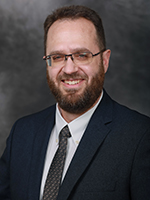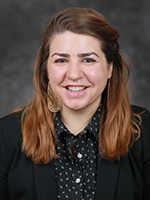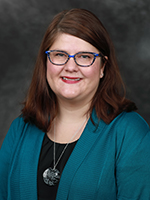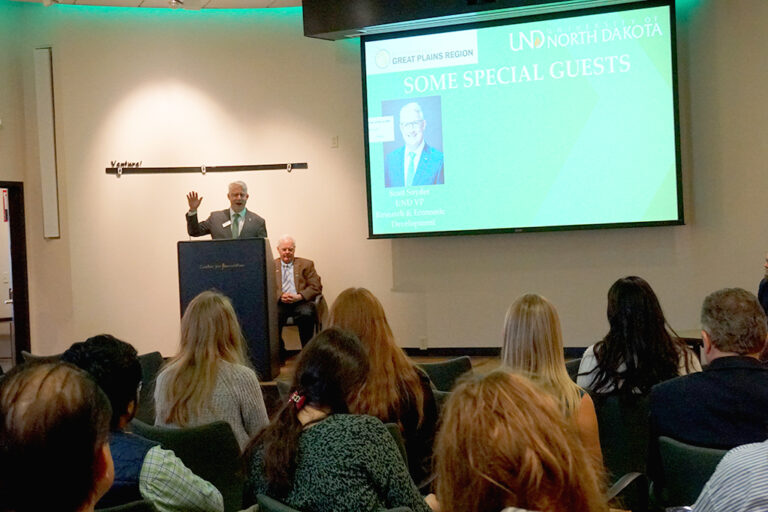UND adds new faculty
Six new members of the University community talk about their first impressions

An opportunity to make a difference.
That’s what new members of the UND faculty family, most of whom came in January, say drew them to join the University.

“The investments in data science and Babcock Hall are exciting,” said Ryan Adams, the first director of the new School of Electrical Engineering & Computer Science in the College of Engineering & Mines.
“My first impression was that the University is very well established. It’s an old school for the United States. That history grounds things here, and it’s a nice feeling,” Adams said. He added that UND alumni are a great resource, and noted the memorial in Upson II Hall to electrical engineering alum Harry Nyquist, who worked for AT&T from 1917 to 1954 and won multiple awards for his work in communication systems.
“It’s nice to see history and how it shapes us moving forward,” Adams said.
He’s looking forward to building the School and the remodel of Babcock Hall, which will house it.
Adams, who will also teach antennas and radio frequency circuits, came to UND from the University of North Carolina-Charlotte.
“I was in the Air Force for 10 years, and wanted to live in a city with an Air Force Base,” said Adams. “I find Grand Forks appealing.”
Feels like home
Grand Forks feels like home, said Cathy Finley, assistant professor of atmospheric sciences.

“I grew up in Benson, Minn., which is 50 miles south of Alexandria,” she said. “I like Grand Forks a lot. It has everything you need.”
Finley, who came to UND from St. Louis University and earned her doctorate at Colorado State University, will teach synoptic meteorology, or how weather systems evolve. She researches tornadoes and storms through both computer modeling and observational methods, and has seen well over 100 tornadoes through the course of her work.
She worked in the wind energy industry for 12 years, and in addition to her storm research, hopes to do some wind energy research.
“I like the University and the department,” said Finley, who added that she had visited UND and knew faculty from the department. “I’m impressed with the facilities. It’s a vibrant department, and the students are excited about weather.”
Role model
The weather comes as no surprise to Beth Klemetsrud, assistant professor of chemical engineering, who describes herself as a “straight-up North Dakotan.”

She grew up in Devils Lake and the White Earth Indian Reservation.
“Grand Forks is home,” Klemetsrud said. “UND is a natural fit, and I really enjoy it. The students are fantastic, and the department is incredibly supportive and congenial.”
Klemetsrud, who teaches unit operations, ethics, and lab classes, conducts research in renewable energy and sustainability assessment.
“I’m looking at energy systems and other processes from the cradle to the grave, that is, from the time material leaves the earth until it finally returns at the end of its useful life, and how to best reduce the environmental impacts of these processes,” Klemetsrud said.
She also plans to work with tribal communities. “I’m most excited when my research positively impacts tribal lands and communities,” she said.
She earned degrees from the University of Minnesota-Duluth and Michigan Tech.
“As an undergraduate, I realized that not a lot of people with my background are faculty,” Klemetsrud said. “I want to be a role model for people with similar backgrounds.”
Informing policy
Ericka Sanner-Stiehr, assistant professor of nursing, is also interested in working with tribal populations.

“Grand Forks came on my radar through the RAIN Program,” she said, adding that her research interests are in health care and the nursing workforce.
She’s interested in recruiting and training nurses to care for tribal and underserved populations, and hopes to look at the issue from an international perspective.
Sanner-Stiehr worked as a nurse in ER departments and in other roles before she earned her doctorate from the University of Missouri-Kansas City.
“I wanted to create information for informed policy and make an impact,” she said. “I want to update policy and protocol and create new knowledge.”
She especially enjoys teaching.
“I really love nursing students,” said Sanner-Stiehr. “That’s the way to make the biggest impact. It’s exponential. They will impact so many other people. It’s an opportunity to do good.”
Excited to teach

Doing good has been a calling since high school, said Ida Drury, assistant professor of social work.
“I’m excited to teach social work,” said Drury. “It’s nice to be surrounded by people who care about social justice and equity. I want to make the world a better place.”
Drury is part of a national research project, the Quality Improvement Center for Workforce Development, which is building evidence for how child welfare agencies improve working conditions for frontline workers. Originally from Houston, Minn., she came to UND from the University of Colorado-Denver.
“I’m looking forward to being a mentor, getting to know students and helping them make a difference,” said Drury. ”My first impression is that I love it here. Everyone is so friendly. UND is a small community within the community of Grand Forks.”
Published poet
Merie Kirby, instructor in honors, jokes that she came to Grand Forks for the cold.

Originally from Westminster in Orange County, Calif., Kirby earned degrees at the University of California-Santa Barbara College of Creative Studies and the University of Minnesota.
“What I like about Grand Forks is that there are so many community activities,” said Kirby. “You can go to something and see someone you know.”
A poet, Kirby has published two books, The Dog Runs On and The Thumbelina Poems. She’s interested in the juxtaposition between the human and natural worlds, including science and folklore.
She’s teaching humanities courses, especially in science and literature, and looks forward to teaching a medical humanities course next fall.
“I really love our honors students,” Kirby said. “They have commitment, creativity and engagement.”


